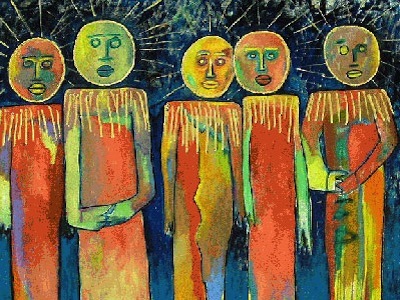
Anthony Central
BAD-ASS BLOG PAGE
A Candle and a Glass of Water

A BRIEF HISTORY
Halloween (or Samhain) is one of the most popular and wide spread pagan festivals in the Celtic calendar and is traditionally regarded as the “Celtic New Year”. In modern times it is a night of fun and celebration, of glowing Jack O’Lanterns, trick or treating and dressing up in costumes as Wicked Witches. It is also a night for divination, for attending séances, tarot card readings and scrying with mirrors. For the occult minded, it is a night of power, when the veil between the unseen world and ours is at its thinnest, a night when the spirits of the departed are free to roam.
When Christianity arrived in the British Isles they tried to eradicate popular pagan practices by replacing them with their own customs, and so Samhain as celebrated on the night of 31st October was renamed “All Hallows Eve”, which later became shortened to “Halloween”. The following day, 1st November, was named “All Saint’s Day”, on which day they would celebrate the spirits of Heaven and pray for those they sent to Hell. On the eve of All Saint’s Day (All Hallows Eve) they developed the custom of banging pots and pans together so the lost souls in Hell would know they were not forgotten.
TRADITIONAL CUSTOMS
Through the ages, Samhain has always been considered an auspicious time for divination, for contacting ancestors and other departed souls. It was customary therefore to place lights along roadways to help guide spirits out for the dark, and to leave open a door or window with a candle or other light burning to lead them back from whence they had left. This was the beginning of the ever popular Jack O’Lantern custom of today, in which lights or candles are placed in pumpkins so the wind will not extinguished them. These are now used to decorate homes and to frighten off mischievous souls who may have lost their way.
Another old custom was to leave out food offerings on their doorsteps, a welcome invitation to the spirits of family members, ancestors, friends, pets and other loved ones to cross the threshold of their home and revisit. After all the hard work of collecting in the harvest, it was also a time for family reunions, when in the warmth and dimly lit smoky rooms of the home, wood and peat for the fire was stacked up high by the hearth, and members of the family all came together to celebrate a winter feast. During the feast bards re-told stories about those long gone, traditional songs would be sung, poetry recited and dances performed in honor of the ancestors.
BRINGING IT HOME
Our earliest ancestors considered the hearth to be the heart of the home. In Latin, the word “focus” meant fireplace or hearth, and certainly supports the idea of it being the focal point of the home and family. The spiritual symbolism of the hearth was representative of Vesta, the ancient Goddess who presided over the wellbeing of the family, and her rituals were performed at the hearth fire every morning and evening. Most importantly, the function of the hearth was to prepare food, which ensured the continuance of the family as well as sharing our hospitality with guests.
Today, the equivalent of the hearth would be the kitchen. I often wonder what it would be like to bring the ancient kitchen rituals to life again in our everyday lives. In ancient times, preparing a meal was always infused with ritual. From preparing the ingredients to finally and reverently consuming the meal, there were specific prayers and incantations of thanks along with a few requests to the gods and family ancestors.
If the favorite food of a deceased relative was prepared, it was not unusual during the preparation to say: “Grandmother, these sweet peppers were your favorite food. I prepare them the way you used to, and will serve them in remembrance of you.” When they were prepared, a sample of them would be placed on the Lararium, or family shrine, and would be offered to her with both reverence and fanfare, thanking her for her recipe and also for continuing the family bloodline.
PUTTING IT ALL ON THE TABLE
So tonight (or any other night for that matter), when you begin to prepare your evening meal, find a picture or a personal object of someone you love who is no longer with you and place it on a shelf in the kitchen. Light a candle next to it, and place a small glass of water behind the picture or object (spirits can move through water), and remember your loved ones as vividly as you can. See their face, hear their voice and feel their touch.
Then, say these words to them:
“My Beloved (name), I bring you gifts of love and joy from life into death. Commune with us, Dear One, and move among us.
At this time while you are alive once more, I take you into my heart to continue to live until next we meet”
Then, simply go about preparing your meal. If you feel inspired, have a conversation with them while you're doing that. When you're about to serve your meal, take a small portion and leave it on the shelf along with their picture, the candle and the glass of water. Don't be surprised if you think you see them out of the corner of your eye, or even in your dreams tonight!
Wishing you all a Happy Halloween!